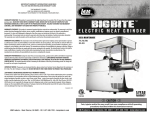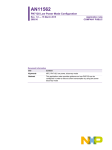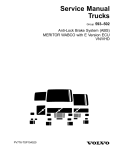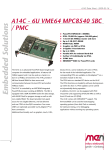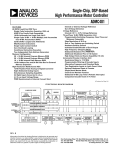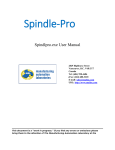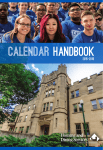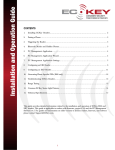Download TSA-6000 Feature Summary
Transcript
TSA 6000™ System Features Summary 2006-03-01 1. TSA 6000™ Introduction ............................................................................................................ 2 1.1 TSA 6000™ Overview ......................................................................................................... 2 1.2 TSA 6000™ Base System ................................................................................................... 2 1.3 TSA 6000™ Software Options ............................................................................................ 2 1.4 TSA 6000™ Hardware Options ........................................................................................... 2 2. TSA 6000™ Hardware................................................................................................................ 3 2.1 Signal Capture..................................................................................................................... 3 2.2 Hardware Specifications...................................................................................................... 4 2.3 Approvals for Use ................................................................................................................ 4 3. TSA 6000™ Software ................................................................................................................. 5 3.1 Network / CPE Signal Analysis Software Module................................................................ 5 3.2 Caller-ID Software Module .................................................................................................. 6 3.3 SMS Software Module (ETSI Protocol-1) ............................................................................ 6 3.4 SMS Software Module (ETSI Protocol-2) ............................................................................ 7 3.5 ADSI Software Module ........................................................................................................ 7 3.6 Russian Caller-ID Software Module .................................................................................... 7 3.7 DTMF and Dial Pulse Analysis Software Module ................................................................ 7 3.8 Wave Exporter Module ........................................................................................................ 7 3.9 P.56 Speech Level Module.................................................................................................. 8 3.10 Terminal Adaptor Module................................................................................................. 9 1 TSA 6000 System Features Summary 1. TSA 6000™ Introduction 1.1 TSA 6000™ Overview The TSA 6000™ Telephone Signal Analysis system includes hardware and software for capturing and analyzing telephony signals (including Caller-ID and other telephony related data signals) on any analog telephone line. The TSA 6000™ Base System includes the hardware and the Network / CPE Signal Analysis Software Module capable of Tone, Ringing, Timing, FFT analysis, and more. Additional software modules are available for specific decoding or protocol analysis (see below). More information regarding the system capabilities, specifications, and demonstration software may be obtained by visiting www.TSA6000.com 1.2 TSA 6000™ Base System The TSA 6000™ Base System includes the following: • • • • • 1- TSA 6000™ Telephone Signal Recorder (hardware) 1- 6’ RS232 cable Network / CPE Signal Analysis Software Module User Guide for hardware operation Software user's manual is provided in the software 1.3 TSA 6000™ Software Options The TSA 6000™ has the following software modules that may be purchased separately. • • • • • Caller-ID Software Module SMS Software Module (ETSI Protocol-1) SMS Software Module (ETSI Protocol-2) ADSI Software Module Russian Caller-ID Software Module Additional software modules may become available as development continues due to customer requests 1.4 TSA 6000™ Hardware Options The TSA 6000™ has the following optional items that may be purchased separately. • • Padded carrying case AC adapters (specify country, voltage, and frequency) 2 TSA 6000 System Features Summary 2. TSA 6000™ Hardware The TSA 6000™ hardware is a stand-alone unit which is lightweight and portable used to connect to a telephone line to capture telephony signaling. • • • • • • • • • • • • • • • Field Upgradeable Firmware (via the RS-232 port) Serial port: 115200 baud (for direct connection to a computer) Modem: V.90 56k (for remote file upload to a TSA 6000™ host computer) LCD with backlight (for control and local display of Type 1 and Type 2 Caller-ID) RJ-11 jacks for easy connection to the line Battery (7.2V NiMH 2700 mAH) or AC adapter (12V 1A class 2) operation Auto switch to battery mode if power loss and battery fault protection Large non-volatile Flash memory (256 Mbit = up to 20 minutes of signal capture) Automatic naming and time-stamping of each captured signal file (up to 256 files) Simultaneous signal recording using AC coupling and DC coupling with time synchronization Signal Capture Trigger Options (FSK, Ringing, Off-Hook, and several others) Start/Stop button for simple "non-triggered" signal capturing Line Termination to terminate line and decode Type 2 (Off-Hook) Caller-ID Monitor mode - Listen to telephone signals on speaker, play back recorded signal files Rugged and lightweight case 2.1 Signal Capture • Capture and record signaling at the customer premise or anywhere on the customer loop • Simple to use one button recording • Add Voice-Notes to any data file for playback locally or with TSA 6000™ PC based Analysis Software • Upload recorded signal files to TSA 6000™ Analysis Software via modem or serial port • Line Termination (switch hook) to terminate line and decode Type 2 (Off-Hook) Caller-ID • Monitor mode - Listen to telephone signals on speaker and play back recorded data files • Separate AC and DC coupled signal capture channels 3 TSA 6000 System Features Summary 2.2 Hardware Specifications AC Coupled Channel • Dynamic Range: 4 Vpp • Sample Rate: 16 k samples/sec • 100Hz - 7KHz (+/-1dB) • Sensitivity: –60dBm DC Coupled Channel • Dynamic Range: +/- 400VDC • Sample Rate: 1K samples/sec • DC - 150Hz +/- 0.5dB • • • • • Telephone Interface On-hook / Off-hook Control 1 M ohm DC (min. ) (On-Hook) 200 ohm DC +/- 5% (Off-Hook) 200 k ohm AC (min.) (On-Hook) 600 ohm AC +/- 5% (Off-Hook) 2.3 Approvals for Use The following regulatory approvals have been obtained for the TSA-6000 Signal Recording Unit: • • • FCC-Part 15 Class A CSA 60950 CE Mark 4 TSA 6000 System Features Summary 3. TSA 6000™ Software The TSA 6000™ software runs on a PC based system running Windows (95 or later supported). The TSA 6000™ software provides the following capabilities: • Connection to the TSA 6000™ hardware for signal file upload • Analysis of captured signals using the powerful TSA 6000™ analysis Software Modules • Playback of captured signals on the PC speakers • Playback of recorded "Voice-Notes" on the PC speakers 3.1 Network / CPE Signal Analysis Software Module The TSA 6000™ Base System includes the powerful Network / CPE Signal Analysis Software Module which has the following features: • Zooming vertical (voltage) and horizontal (time) of any captured signal • Browser-like controls for back / forward to previous zoom views • Accurate timing measurements using cursors • Time synchronization of AC coupled and DC coupled signal capture buffers • FFT Analysis of any selected signal segment • Filtering of captured signals before analysis (lowpass, highpass, bandpass) • Automatic detection, display, and analysis of telephony signals. All signal detection parameters can be redefined by the user or the system defaults can be used. The following signals are automatically detected by the TSA 6000™ Network / CPE Signal Analysis Software Module. When a signal is detected, it is displayed on the screen, and the signaling parameters are shown with the detected signal. The criteria used to automatically detect each signal is controllable by the user. • Dialtone: level and frequency • Stutter Dialtone: level, frequency, and cadence • Busy Tone: level, frequency, and cadence • Ringback Tone: level, frequency, and cadence • FAX CNG and CED Tones: level, frequency, and duration • Single Frequency Tones: level, frequency, and duration (any frequency tone) • DTMF: frequency, amplitude, twist, duration • CAS: frequency, amplitude, twist, duration • SAS: frequency, amplitude, duration • Noise: single frequency interference tones • Ringing: level and cadences • Power Line Harmonics • DC level changes for Extension-In-Use • On-hook Extension-In-Use (EIU) checks (for Type 2 CID) • Flash signal timing • Open Switching Interval (OSI) timing, level • Line Reversals • Voltage Message Waiting Signals 5 TSA 6000 System Features Summary 3.2 Caller-ID Software Module The TSA 6000™ Caller-ID Software Module supports detection of signals and decoding data for Caller-ID signaling for the TIA-777A / Bellcore SR-3004 and the ETSI EN 300 659 signaling and data formats. Both Type 1 (On-Hook) and Type 2 (Off-Hook) Caller-ID are supported. The following parameters are automatically detected and the signaling parameters and data displayed. • FSK Mark and Space amplitude and frequency • FSK Twist • FSK Baud Rate • Channel Seizure delay • Channel Seizure length • Channel Seizure dropout • Mark preamble length • Mark preamble dropout • Start/Stop framing errors • Bit inversion • Stuffed Mark Bits • Checksum errors • FSK Signal-To-Noise Ratio (SNR) • Interference tones • FSK delay (for Type 2 Caller-ID) • All decoded FSK data bytes can be displayed as HEX, ASCII or as the named decoded Message Types, Parameters Types and Data (e.g., Calling Name Parameter). • Decoded data is also displayed in a easy to read format as would be seen on a Caller-ID CPE display. • Out-Of-Spec. signaling parameters are highlighted in RED In addition to the FSK signaling parameters, the base TSA-6000 software provides analysis of: • CAS (CPE Alerting Signal) parameters (duration, frequencies, amplitude, twist, noise) • DTMF-ACK parameters (duration, frequencies, amplitude, twist, noise) • Ringing parameters (voltage (max, min, RMS), frequency, duration, DC) 3.3 SMS Software Module (ETSI Protocol-1) Short Messaging Services (SMS) protocols are defined by ETSI for land line SMS services. The TSA 6000™ SMS Software Module-P1 supports decoding of ETSI Protocol-1 messages and parameters and all decoded data is displayed in an easy to read format. . The FSK signaling analysis described for the Caller-ID Software Module is also provided in the SMS Software Module. 6 TSA 6000 System Features Summary 3.4 SMS Software Module (ETSI Protocol-2) Short Messaging Services (SMS) protocols are defined by ETSI for land line SMS services. The TSA 6000™ SMS Software Module-P2 supports decoding of ETSI Protocol-2 messages and parameters and all decoded data is displayed in an easy to read format. . The FSK signaling analysis described for the Caller-ID Software Module is also provided in the SMS Software Module. 3.5 ADSI Software Module The Analog Display Services Interface is defined in Bellcore TR-1273 and SR-2461. ADSI signaling is similar to Caller-ID signaling using FSK and DTMF. ADSI signaling is more complex including handshaking, error detection acknowledgment signals and a longer list of data parameter types defined. The ADSI Software Module will automatically decode all ADSI parameters and display the data in an easy to read format. The FSK signaling analysis described for the Caller-ID Software Module is also provided in the ADSI Software Module. 3.6 Russian Caller-ID Software Module Russian Caller-ID uses a unique signaling method whereby a sequence of concatenated dual tone signals (similar to DTMF) are sent by the CO switch after a signaling handshake is completed. The Russian Caller-ID Software Module displays all signaling parameters for the digits decoded and also shows the decoded meaning of each digit sequence. 3.7 DTMF and Dial Pulse Analysis Software Module This module is used for convenient analysis of DTMF signals. The features are used by activating this module and capturing DTMF signals and then selecting the "Automatic Analysis" option. The TSA software then displays a formatted text display which can be saved (exported) to an excel readable CSV file. All DTMF parameters are measured and recorded including: • Frequencies • Amplitudes • Total power • Twist • Duration • Inter-digit timing • Distortion (note: DTMF distortion measurements are only available with this software module) Dial Pulse signals will also be automatically analyzed with the relevant timing (make time, break time, inter-digit timing) output into a exportable data file. 3.8 Wave Exporter Module This module is used to export the AC component of captured files into wave files. 7 TSA 6000 System Features Summary 3.9 P.56 Speech Level Module This module is used to measure active speech levels of recorded files. Uses the ITU P.56 (methodB) algorithm. 8 TSA 6000 System Features Summary 3.10 Terminal Adaptor Module This module is used to test the analog portion of Terminal Adaptors. This includes ADSL and set top box VoIP terminals adapters,. There are many issues with compatibility of terminal adaptor devices when connecting to the existing installation of analog telephones/CPE equipment. The following tests are provided: • DTMF Generation (single digit): o Control of individual parameters of: o Tone frequencies o Tone amplitudes (and twist) o Duration o Single frequency interference • Pre-configured DTMF Test Suites: o Group 1: Nominal parameters) o Group 2: All parameters at 100% of TIA-470-C allowable tolerance (individual parameters) o Group 3: All parameters at 100% of TIA-470-C allowable tolerance (all combinations) o Single Frequency Interference (SFI): All digits with SFI from low to high level o Amplitude variation o Duration variation o Twist variation o Inter-digit delay variation o Frequency (only) variation • Flash Signal Generation o Test Suite with Flash duration varied from 300 ms to 1500 ms • Extension In-Use Generation o Test Suite with duration varied from 3 ms to 20 ms o Test Suite with ACK Delay varied from 0 ms to 150 ms • Ringing Signals o Can be tested with the base TSA-6000 software ringing analysis capabilities. • DC voltage Characteristics o Can be tested with the base TSA-6000 software analysis capabilities. 9 TSA 6000 System Features Summary TSA-6000 Terminal Adapter Test Interface 10










